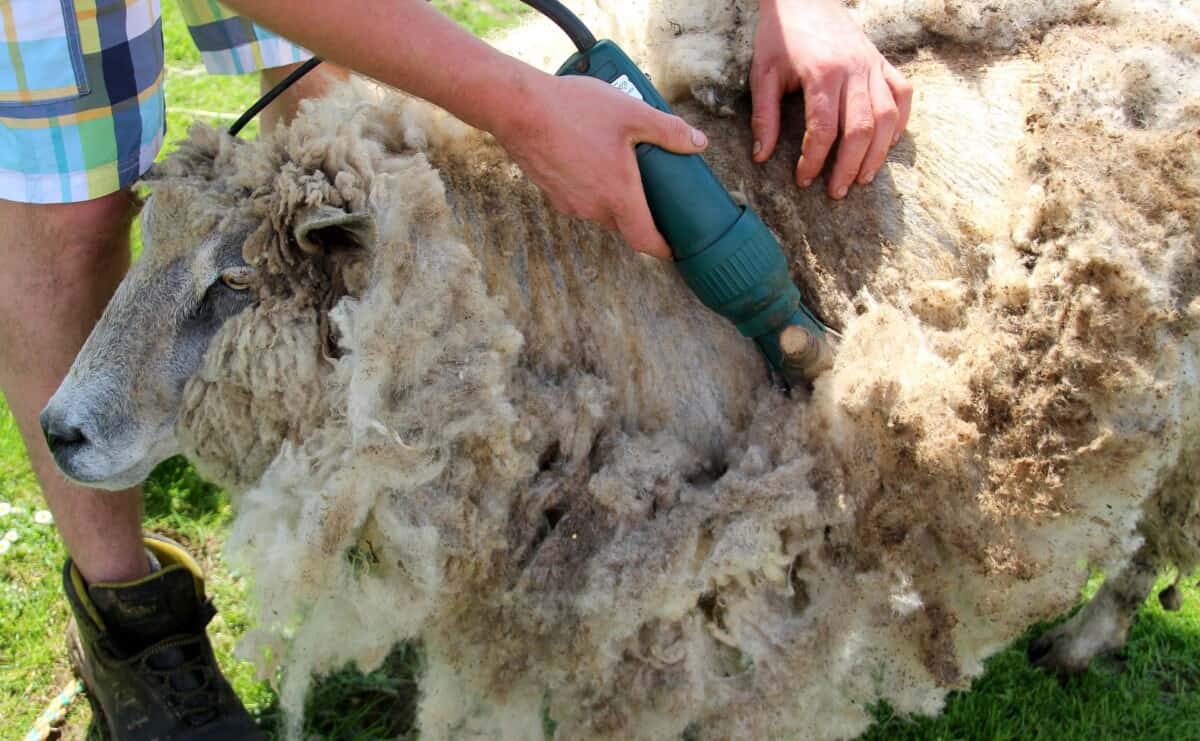In our previous articles we have talked about sheep and how to pick the best breeds and how to breed them or how to deliver little lambs. As we have mentioned before, sheep are good farming animals for many reasons, but one of the most popular and important aspect of sheep is its wool. This article will be dedicated to the matter of how to value your sheep wool.
First of all, as we have mentioned before there are hundreds of different sheep breeds and each of them are different. Some have horns, some bigger and some have different types of wool. The quality of sheep wool depends mostly on the climate they live in. If the climate is cold, the wool will be bigger and warmer. The coat helps sheep to stay warm. In more arid environments, you will be looking at thinner more sparse wool.
Farmers usually start to trim the coat in spring, the shearing season. But the timing needs to be done right. Sometimes it seems that cold winter days are over and warm spring is here, farmers can usually start trimming their sheep and prepare the wool for retail purposes. If they are not careful enough and the cold weather shows up again, sheep can easily die from cold. Remember, you should always take measures before removing coat from sheep, because in the worst cases you can lose the whole herd.
Specialties of Sheep Wool
Sheep wool is obtained manually by shearing it from sheep. After that, it is very important to sort it depending on the colour, length of the hair, as well as its thickness. Then, after washing, the wool is very carefully combed and divided into fibers. It is worth noting that when processing wool, lanolin is stored in it, which gives the wool its unique properties.
Unique properties and advantages of sheep wool:
- Sheep bedding is hygroscopic, meaning it absorbs moisture well. Surprisingly, sheep’s wool can absorb up to 35% of its own weight before coming saturated, remaining completely dry.
- Excellent thermoregulation: wool fibers create a kind of barrier, so the body is not threatened by a rising or falling temperatures.
- The high content of active substances and lanolin prevent the contamination of woolen products and is excellent at keeping the wool pure for sale.
- Thanks to the lanolin already well known to us, sheep’s wool is hypoallergenic and does not usually cause allergic reactions on the skin. The content of sheep’s wool in bedding has analgesic, bactericidal and anti-inflammatory properties.
Types of sheep wool
Types of sheep wool are determined by the fibers that make up the coat.
Homogeneous wool
Consists of fibers of the same type – downy or transitional. Homogeneous wool is thin, semi-thin and semi-rough.
Thin wool
Obtained from sheep of fine-wool breeds consists of down fibers having a fineness of not more than 25 microns (not coarser than the 60th quality). The length of the wool in the staple is 7-9 cm. The yield of pure (washed) fiber is 45-50% or more. This is a valuable raw material for high-quality wool or mixed products. Fine quality wool is divided into merino and non-merino.
Merino wool
Super-white, soft, elastic, well-balanced in fineness and length. This raw material is used in the manufacture of first class felt of special quality, as well as colored felt. First class felt is used in interior design, in design and creativity, in shoe and clothing production, for the final polishing of hard materials.
Non-merino
Wool from merino wool is different by a lack of uniformity of wool fibers in fineness and length, and less curl. Wool can be white, light gray and colored (gray, dark gray, brown, black).
Semi-fine
wool consists of fibers coarser than fine wool, mainly from transitional or a mixture of transitional fibers and coarse fluff. Semi-fine wool is obtained from sheep of semi-fine-fleeced breeds, as well as from cross-breed animals (from crossing rough-haired females with fine-fleece and half-fine-fleece sheep).
Fine wool
Wool of the second class is produced from this raw material. This type of felt is beautifully dyed, used in interior decoration, in design and creative work, in shoe and clothing production, for the final polishing of hard materials.
Semi-rough wool (homogeneous)
Consists of wool fibers with a fineness of 48th quality and coarser (31.1-40 microns). Such wool is given by Russian long-haired sheep, Lincoln, etc.
Inhomogeneous wool
Consists of fibers of different types – spine and transitional fiber. This includes coarse and semi-coarse wool, light gray and dark in color.
Semi-rough wool
Consists of fluff, transitional fibers and a thin spine. This wool is obtained from semi-coarse-haired breeds and cross-breeding animals (from crossing of coarse-haired females with sheep of fine-wool and half-fine-wool). The length of the hair of spring haircuts reaches 110-190 mm (in some breeds 230 mm), autumn – 80-110 mm. Semi-coarse wool – (light gray and dark) is a valuable raw material for the production of technical semi-coarse felts of class 4, as well as cloth, carpets, knitted yarn, etc.
Coarse wool
Characterized by the presence in its composition of all types of wool fibers: fluff, transitional fiber, spine, often dry or dead hair. The ratio of different types of fibers in the wool can be different depending on the breed and within the breed characteristics of the sheep, which determines the value of coarse wool. Coarse wool (light gray and dark color) is a valuable raw material for the production of technical coarse-wool felt of the 5th class.
Physical And Technical Properties Of Wool
Qualitative indicators of wool and fluff determine: fineness, length, crimp, strength, extensibility, elasticity, elasticity, color, gloss, moisture, fat content.
There are some indicators of the important systematic features in the evaluation and classification of sheep and wool. It is determined by measuring the diameter of the cross section of the wool fiber and is expressed in thousandths of a millimetre — micrometers (μm).
The fineness of the coat depends on the breed, feeding and keeping conditions, sex of the animals, their age and individual characteristics.
Young animals have a finer coat than adult sheep. With age, the wool coarsens, and after 5-6 years of age, due to the weakening of the vital functions of the body, the hair becomes thinner. In females, wool is thinner than in rams.
The thinnest wool is obtained from sheep of fine-wool breeds (25 microns and thinner). Sheep of semi-fine-crowned breeds gives wool fineness of 25.1 microns and coarser. Fine wool and coarse-haired crossbreeds can give such wool. The wool of sheep of semi-coarse and coarse-haired breeds is mainly heterogeneous. Depending on the fineness, homogeneous wool in our country is divided into 13 classes, called qualities, which are designated by the specially given numbers.
Indicators for wool purpose
Length is one of the important indicators that determine the production purpose of wool, the class of fine-wool and semi-fine-wool sheep and the runes obtained from them. Distinguish between natural and true coat length.
The natural length is the height of the staple or pigtail with natural tortuosity or waviness of the hairs. It is measured with a ruler with an accuracy of 5 mm. Two dimensions are determined in a pigtail — the length of the spine and the length of the downy tier. These measurements are written in fractions: in the numerator is the total length of the braid (spine), in the denominator is the length of the downy tier.
True length is the length of wool fibers in a straightened but unstretched state. It is measured with an accuracy of 1 mm. To determine the true length, devices (for fibers up to 200 mm long and for fibers up to 350 mm long) are used.
The growth of wool in length depends on the breed, sex and age of the sheep, the level of their feeding, keeping conditions and other factors. The shortest wool is sheep of fine-wool breeds (6–9 cm). Sheep and rams produce longer hair than female. In young animals up to a year old, wool grows faster than in adult sheep;
Within 4-5 years, the growth of wool for the year is approximately the same, and after 5-6 years of age, the growth rate of the wool slows down. At a low level of feeding, the growth of wool slows down, the fiber thins, its strength decreases. The length of the coat in different parts of the animal’s body is different: on the shoulder blades, sides, thighs it is longer than on the belly and back.
Curliness is characteristic of wool fibers of all types, except for covering hair. Curl – a valuable feature of wool – helps protect the fleece from getting into it mechanical impurities and precipitation. It is taken into account when scoring sheep and grading wool. In thin and semi-fine wool there are three main forms of crimps: normal, flat and high. If the twists are close in shape to a semicircle, they are called normal, which is typical for fine-wool sheep.

